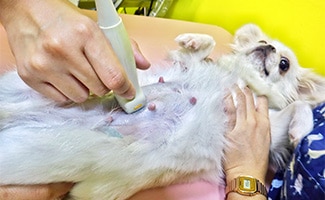How Long Are Dogs Pregnant? Timeline, Symptoms & Expectations
To keep the lights on, we receive affiliate commissions via some of our links. Our review process.

Are you awaiting the pitter-patter of little paws in your household? Or perhaps you are considering breeding your dog? Either way, there is a lot to know about dog breeding! This article will explain how long a dog is pregnant, what to expect when it comes to pregnancy in dogs, and critical things to consider before you embark on breeding for the first time.
How Does A Dogs’ Reproductive Cycle Work?
The average canine reproductive cycle is very different from ours as humans. Most dogs will usually come into heat approximately every six months. Small breed dogs may cycle a little more frequently than this, and giant breeds may cycle as infrequently as once per year. Smaller breeds will have their first heat cycle earlier than larger breeds.
The cycle happens in four stages:
- Proestrus – Proestrus is the first stage of the cycle and can last around nine days. Your bitch may be attractive to males at this time, but she will likely reject their advances! Signs of proestrus include a swollen vulva and bloody discharge.
- Estrus – Estrus can last for 3-11 days. This is when she is receptive to the male dog and is at her most fertile. The discharge she is producing will begin to lighten in color during this time and decrease in volume. Professional breeders will use a combination of vaginal examinations and blood testing to predict ovulation and increase the likelihood of successful mating.
- Diestrus – Diestrus is the final stage. She will no longer be receptive to the male dog, and her discharge will decrease, eventually stopping. Her vulva will return to normal size and shape. The heat is complete when all signs of swelling and discharge have gone.
- Anestrus – Anestrus is the period between cycles where the female dog is not reproductively active.
How Can I Tell If My Dog Is Pregnant?
Sadly, pregnancy testing is not as straightforward for dogs as for humans. Here are some of the ways your veterinarian will be able to advise if your dog is pregnant:
Hormonal Testing
A blood test can be performed from around day 25 from mating. This blood test measures the levels of a hormone called relaxin. Relaxin is produced by the developing placenta, connecting the developing embryo to a mom’s uterus.
Palpation
Between three to five weeks pregnant, your veterinarian may be able to feel the puppies through your dog’s belly. This isn’t always easy for several reasons, so it is not the most accurate way to diagnose pregnancy. It also will not give a precise estimate of the number of puppies present. As a dog’s pregnancy continues, it can be harder to palpate the puppies in the abdomen as the uterus changes in size and feel.
Ultrasound

From around 25 days after mating, your veterinarian will be able to perform an ultrasound scan to look for developing embryos. An ultrasound scan also allows your veterinarian to assess whether the fetus(es) are alive by detecting heartbeats (this is usually possible from around day 28).
An ultrasound scan can also rule out other causes of abdominal swelling if pregnancy is only one possibility. Ultrasound can also be used to estimate the gestational age of the fetuses by taking measurements. Caution should be taken in estimates of litter size from an ultrasound scan. Due to movements in the abdomen and the fact that it is impossible to see the whole uterus in one image during the procedure, sometimes puppies may be missed or counted twice.
X-rays
Taking an x-ray picture of a dog’s tummy can be used to confirm pregnancy and give an accurate idea of how many puppies your dog might be expecting. However, there are some risks, both by exposing the developing puppies to a dose of radiation and potentially causing stress for the mom by restraining her for a clear picture.
You should weigh up the benefit carefully with your veterinarian. If an x-ray counts the number of puppies present, it is best to do it after day 55 as their bones are well mineralized (and easier to see). It’s important to note that even with an x-ray, a puppy can hide from time to time, leading to surprises!
What To Expect From Your Dogs Pregnancy
How Long Will My Dog Be Pregnant?
In dogs, pregnancy will last approximately nine weeks – or around 63 days from the point of conception (egg fertilization). This can, however, vary by several days. As both eggs and sperm can survive for a short period in the reproductive tract, the day of mating will not accurately measure gestation.
Pregnancy Time Line
Here’s an overview of what to expect when your dog is expecting puppies.
Month One
After fertilization, the embryos will implant in the uterine lining at around day 16. Around day 28, your veterinarian should be able to detect a heartbeat via ultrasound scanning. Many dogs will not show obvious signs in the first few weeks of pregnancy. Still, you may notice increased appetite, slight enlargement of the nipples, or occasional vomiting (if your dog regularly vomits, she should see your veterinarian).
Month Two
The puppies will be developing rapidly at this stage. You may notice signs of pregnancy include increased appetite, weight gain, urination, and behavioral changes. She may have a clear, odorless discharge. If she has any colored or smelly discharge, speak to your veterinarian as this is likely abnormal. You may even notice the puppies moving in a dog’s dog’s tummy from around day 50 of her pregnancy.
Month Three

At the start of the third month, if not slightly before, your bitch is ready to have her puppies. The puppies are usually fully developed from around day 58 and will begin moving towards the birth canal.
You bitch may become noticeably trimmer as the puppies move, and you may notice a drop in her appetite a day or two before she goes into labor. She will likely start showing nesting behaviors. Her body temperature, measured with a thermometer, may drop slightly around 12 to 24 hours before she goes into labor.
What Are The Signs Of A Dog In Labor?
Dog labor can be split into three stages:
- The first is the start of her contractions. Your dog may be restless, hideaway, pant, or refuse her food. Some dogs may even vomit a little.
- During the second stage, the puppies will be delivered. This can take anywhere from 1 to 24 hours. Each puppy should take no more than 1 to 2 hours to arrive, and usually, they will have between 30 and 60 minutes between each puppy.
- The third stage is delivery of the placentas, which occurs alongside stage 2 and will typically finish soon after the last puppy has arrived.
Contact your veterinarian if your dog has been in labor for more than 24 hours, if there have been more than two hours between puppies or if you see signs of puppy distress such as green discharge. These can be signs of serious complications.
How Many Puppies Will My Dog Have?

Knowing how many puppies to expect can be very helpful as a dog breeder to ensure you have the perfect new homes ready and waiting. Normal litter size in dogs can vary from a single pup to around 12 puppies (although larger litters are possible!).
However, each breed has its variation in average litter size, with a rule of thumb being that larger breeds tend to have larger litter sizes and small or toy breed dogs tend to have small litter sizes. The American Kennel Club has collated registration data on litter size for the ten most popular breeds in the United States here.
It can be very tricky to accurately estimate how many puppies your dog will have, even with an ultrasounds scan, and you may end up with more or fewer puppies than predicted.
My Dog’s Pregnancy Was Accidental. What Should I Do?
If your dog accidentally mates during her heat cycle, you should contact your veterinarian as soon as possible. Mismating injections can be administered to terminate the pregnancy. They should ideally be administered as quickly as possible after the mating, up to 45 days. Your veterinarian will be able to discuss the risks and cost of the injections with you so you can make an informed decision if it is the right approach for your dog.
How Often Can My Dog Have Puppies?
Having a litter of puppies is very demanding on your dog. Biologically, a healthy dog can carry a litter of puppies every season. But you should consider many other factors before breeding your fur baby in back-to-back seasons.
- Did she have complications or need a cesarean section?
- Was she a good mom, and did she look after her puppies well?
- Were the puppies healthy?
- Do you have the emotional and financial resources to have another litter quickly?
Reputable breeders will carefully consider the ethical merits of each litter they plan from their bitch and retire her as soon as appropriate – even if this is after only a single litter. There are also legal limits on the number of litters a dog can have in some countries, so do your research carefully.
There is not a one size fits all to this question, and it is best to discuss your situation with your veterinarian to understand.
Things to Consider Before Breeding From Your Dogs
Cost

With prices of puppies at an all-time high, breeding a litter from your dog may seem financially tempting. However, it is essential to remember that there can be significant costs associated with dog breeding. Especially if your bitch develops complications during birth that require an emergency cesarean section at an after-hours veterinary clinic. Some breeds of dogs will almost certainly require a cesarean section as they now struggle to give birth naturally due to breeding for exaggerated traits. Examples include breeds such as the British and French Bulldog.
Even if things are smooth sailing throughout pregnancy and birth, mom and babies will still need to be cared for, including whelping boxes, anti-parasite treatments, dietary supplementations, and veterinary health checks, all of which can add up quickly.
Hand Rearing
If you are thinking about breeding, be prepared for situations where a mom might not be able to feed her babies. In the worst case, if something goes wrong, you may be left with orphans, but sometimes, they don’t have enough milk or refuses to care for the puppies. Hand-rearing is a full-time job in those early days, and your puppies will need to be fed every few hours, around the clock. They will need to be fed puppy formula, which can be costly.
A Healthy Dog Mom Is A Happy Dog
Breeding from your dog is a big undertaking for both you and her. While it can be gratifying, it should never be taken lightly. If you are thinking about breeding your dog, chat to your local veterinarian, who can give you tailored advice to ensure it is the right choice for you and your furry friend. Learn more about dogs in heat and the benefits of spaying and neutering your pet.
Tagged With: Spay Or Neuter




